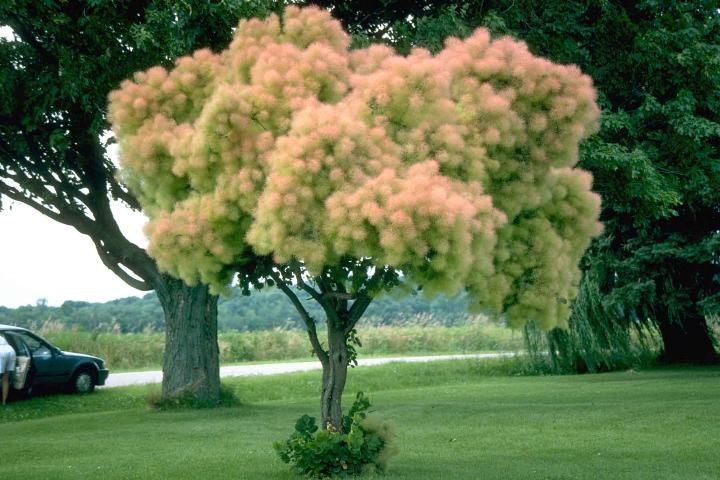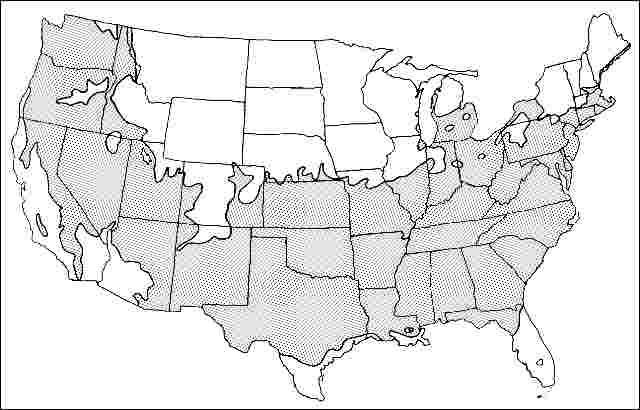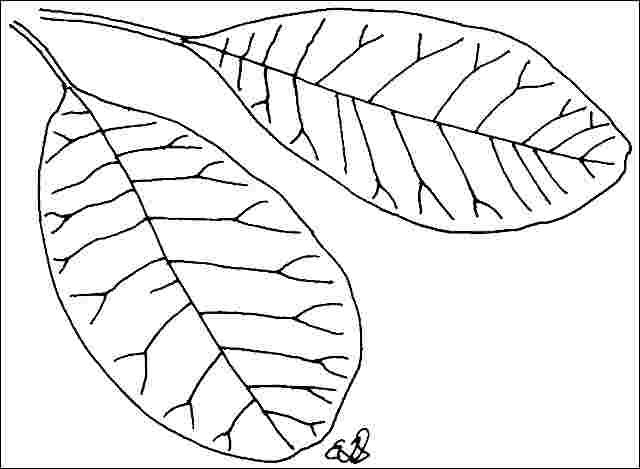Introduction
This slow-growing, moderately dense-crowned, small tree eventually reaches to 10 to 15 feet tall (occasionally 20) and 10 to 15 feet wide. On this cultivar, the large panicles of wispy maroon-colored flowers produced in spring and early summer give the effect of a cloud of grayish-red smoke. They make a wonderful, dense accent in a shrub border and can be planted as a specimen or as a patio tree where the black, showy, multiple trunks can be displayed. Planting Smoketree is a good way to extend the spring flowering-tree season into the summer before the Crape-Myrtles come into full bloom. Fall color is usually good to excellent and ranges from yellow to orange and brilliant red-purple. Many people grow it simply to enjoy the vivid fall color.

Credit: Ed Gilman, UF/IFAS
General Information
Scientific name: Cotinus coggygria
Pronunciation: koe-TYE-nus koe-GUY-gree-uh
Common name(s): 'Daydream' Smoketree, 'Daydream' Wig-Tree, 'Daydream' Smokebush
Family: Anacardiaceae
USDA hardiness zones: 5B through 8B (Figure 2)
Origin: not native to North America
Invasive potential: not assessed/incomplete assessment
Uses: specimen; deck or patio; street without sidewalk; container or planter; reclamation; trained as a standard; screen; parking lot island < 100 sq ft; parking lot island 100-200 sq ft; parking lot island > 200 sq ft; tree lawn 3-4 feet wide; tree lawn 4-6 feet wide; tree lawn > 6 ft wide; highway median

Description
Height: 10 to 15 feet
Spread: 10 to 18 feet
Crown uniformity: symmetrical
Crown shape: round
Crown density: dense
Growth rate: slow
Texture: medium
Foliage
Leaf arrangement: alternate (Figure 3)
Leaf type: simple
Leaf margin: entire
Leaf shape: obovate, elliptic (oval)
Leaf venation: reticulate, pinnate
Leaf type and persistence: deciduous
Leaf blade length: 2 to 4 inches
Leaf color: blue or blue-green, green
Fall color: yellow, orange, red, purple
Fall characteristic: showy

Flower
Flower color: pink, white/cream/gray
Flower characteristics: very showy
Fruit
Fruit shape: oval, irregular
Fruit length: less than 0.5 inch
Fruit covering: dry or hard
Fruit color: brown
Fruit characteristics: does not attract wildlife; showy; fruit/leaves not a litter problem
Trunk and Branches
Trunk/bark/branches: branches droop; showy; typically multi-trunked; thorns
Pruning requirement: little required
Breakage: resistant
Current year twig color: brown
Current year twig thickness: medium, thick
Wood specific gravity: unknown
Culture
Light requirement: full sun
Soil tolerances: clay; sand; loam; acidic; alkaline; well-drained
Drought tolerance: high
Aerosol salt tolerance: moderate
Other
Roots: not a problem
Winter interest: no
Outstanding tree: yes
Ozone sensitivity: unknown
Verticillium wilt susceptibility: susceptible
Pest resistance: resistant to pests/diseases
Use and Management
The tree is tough and adapts to restricted soil spaces. It could be used along a street under power lines and would not require pruning for many years. It is a small tree, well-adapted to urban areas with almost year-round interest which should be used more in our landscapes.
Smoketree grows best in a sunny location and a well-drained loam. It will grow asymmetrically and lean toward the light in a partially sunny area, so it is best to locate it in full day sun where the crown will develop symmetrically. Though sometimes short-lived in rich soil, Smoketree is useful in dry, rocky soil where there is no irrigation. It also grows in a wide range of soil pH, including alkaline. Probably short-lived (20 years—maybe more) in most situations but who cares - the tree is great while it's around!
Propagation of cultivars is by cuttings.
Cultivars include: 'Flame'—brilliant orange-red fall color, pink inflorescences; 'Nordine'—resembles 'Royal Purple'; 'Notcutt's Variety'—dark maroon-purple leaves (also known as 'Foliis Purpureis Notcutt's Variety' and 'Rubrifolius'); 'Purpureus'—leaves bronze-green, inflorescences purplish-pink; 'Royal Purple'—leaves are darker purple than 'Notcutt's Variety', rich red-purple fall color, purplish-red inflorescences; 'Pendulus'—pendulous branches; and 'Velvet Cloak'—dark purple-leaf form, spectacular fall color of reddish-purple.
Pests
Oblique-banded leaf roller mines and rolls the leaves, usually in June. The insect rarely occurs in sufficient numbers to warrant control. When it does occur, they can be picked off by hand or sprayed with Bacillus thuringiensis.
Diseases
Leaf spots can be caused by various genera of fungi but are usually not serious.
Scab may cause leaf drop. No controls are listed.
The most serious disease is Verticillium wilt. Smoketree is very susceptible, and entire branches wilt and die. Prune out infected branches, fertilize, and water the plant during dry weather.
A stem canker can be a problem in the eastern US.